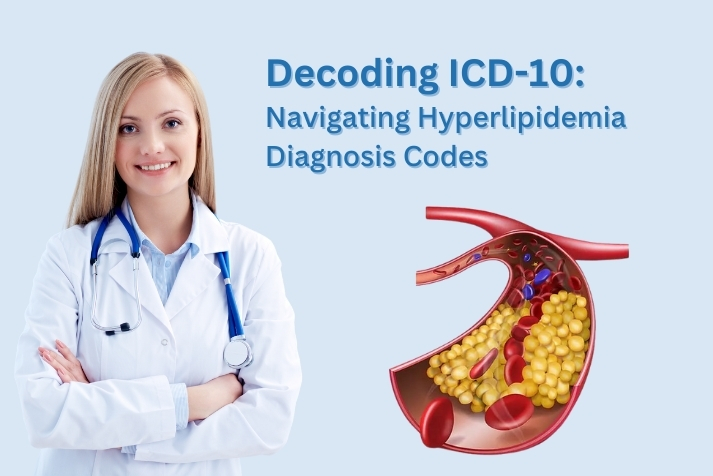Efficient healthcare management depends on precisely identifying and recording conditions in the complicated world of medical coding. Problems related to high lipid levels, such as hyperlipidemia and dyslipidemia, are frequently observed. By demystifying the ICD-10 codes linked to these ailments, this article hopes to give medical practitioners a thorough manual for correct coding and billing.
Recognizing dyslipidemia and hyperlipidemia
Let’s first explain the differences between hyperlipidemia and dyslipidemia before getting into the nuances of ICD-10 codes in more detail. The term “hyperlipidemia” broadly describes high blood lipid levels, such as triglycerides and cholesterol. Conversely, dyslipidemia specifically refers to an imbalance in lipid levels, which can include both high and low levels.
ICD-10 Hyperlipidemia Codes
Hyperlipidemia ICD-10 Code: E78.0
E78.0 is the generic designation for hyperlipidemia. When further information on the kind of hyperlipidemia is required, this code is used.
Hyperlipidemia Unspecified ICD-10 Code: E78.9
E78.9 is assigned when the precise form of hyperlipidemia is unknown. In situations where a thorough diagnosis is either unavailable or equivocal, this code is applicable.
E78.1 is the ICD-10 code for high cholesterol:
Hyperlipidemia and elevated cholesterol are frequently interchangeable terms. High cholesterol is especially addressed by code E78.1, which helps with accurate coding for this prevalent ailment.
High Cholesterol Unspecified (ICD-10) Code: E78.2
E78.2 is the code to use when the kind of excessive cholesterol is not stated. When it comes to capturing situations with scant diagnostic data, this code offers versatility.
ICD-10 Code for Familial Hyperlipidemia: E78.2
The ICD-10 designation for familial hyperlipidemia is E78.2. It is a genetic condition. Accurate representation in medical records is ensured for familial cases by proper coding.
ICD-10 Dyslipidemia Codes
Dyslipidemia ICD-10 Code: E78.5
E78.5 is the general code for dyslipidemia. This code provides a thorough coding solution by covering a variety of illnesses marked by aberrant lipid levels.
E78.6 is the ICD-10 code for mixed hyperlipidemia.
E78.6 is assigned when there are high triglycerides in addition to raised cholesterol. Mixed hyperlipidemia intricacy is explained by this code.
Dyslipidemia Unspecified (ICD-10) Code: E78.9
In cases where a particular kind of dyslipidemia cannot be identified, the code E78.9 is applicable. This code helps identify cases that don’t have enough diagnostic information.
Utilizing specific ICD-10 codes:
To accurately reflect the patient’s condition, healthcare providers need to select the most appropriate ICD-10 code carefully. For example:
E78.5 for dyslipidemia:
When dyslipidemia is diagnosed, use code E78.5. This code describes the abnormal lipid levels without focusing on any specific type.
E78.0 for Particular Types of Hyperlipidemia:
When the particular code for a comprehensive diagnosis of hyperlipidemia, such as increased triglycerides or cholesterol, is known, use it.
E78.2 for Familial Hyperlipidemia:
Designating E78.2 in hereditary hyperlipidemia cases guarantees precise documentation of the condition’s familial component.
Exploring some additional ICD-10 codes for hyperlipidemia:
In addition to the main codes above, several other ICD-10 codes are essential for treating other facets of hyperlipidemia. Let’s examine a few more codes and situations:
Hyperchylomicronemia (E78.3):
This code is reserved for situations in which the blood contains an excessive amount of chylomicrons. The exact coding for this specific subtype of hyperlipidemia is ensured by the accurate usage of E78.3.
Other Hyperlipidemia (E78.4):
This broad categorization for “other” hyperlipidemia allows for flexibility in coding when dealing with instances that don’t cleanly fall into regular categories.
Pure Hyperglyceridemia, Unspecified(E78.70):
This code is very helpful in identifying cases of considerably high triglyceride levels when the precise kind is either unknown or undocumented.
Pure Hyperglyceridemia, Familial(E78.71):
This code helps medical practitioners identify inherited characteristics in hypertriglyceridemia patients by designating them differently.
Taking a Closer Look at ICD-10 Code E78.5 – Dyslipidemia:
Overview of E78.5:
A range of dyslipidemias, including those with increased, decreased, or unbalanced lipid levels, are encompassed by the E78.5 code. This is a flexible code that requires careful assessment of the particular diagnosis when used.
Common Scenarios for E78.5:
E78.5 for General Dyslipidemia:
E78.5 acts as a catch-all designation for dyslipidemia when a patient’s lipid levels depart from the norm without making a clear difference between high and low.
E78.5 for Mixed Hyperlipidemia: Mixed hyperlipidemia is defined as situations in which there is a concurrent rise in triglycerides and cholesterol. This intricacy is aptly captured by the assignment E78.5.
E78.5 for Dyslipidemia Caused by Other Substances or Medical Drugs:
There are drugs and chemicals that can affect lipid levels. The correct code to use for recording dyslipidemia that is caused by external sources is E78.5.
Practical Application of ICD-10 Codes:
Let’s look at an example patient scenario to demonstrate how these codes are used in practice:
Case Study:
A 45-year-old man without a particular diagnosis of dyslipidemia arrives with high cholesterol, a family history of hyperlipidemia, and raised cholesterol values. Tests performed by healthcare professionals show elevated levels of triglycerides and cholesterol.
Coding in the case:
In this case, the supplier would make use of:
E78.1 for elevated cholesterol,
E78.2 for familial hyperlipidemia, and
E78.5 for the overarching diagnosis of dyslipidemia.
Emerging Trends and Considerations in Hyperlipidemia Coding
Medical coding intricacies are subject to continuous evolution in tandem with healthcare practices. Hyperlipidemia coding considerations and recent trends highlight how dynamic healthcare documentation is:
Integration of Electronic Health Records (EHR):
The process of documentation has been made more efficient by the widespread use of EHR systems. Healthcare providers must, however, make sure that patient diagnoses are appropriately captured by these systems and converted into the appropriate ICD-10 codes. Gaining expertise in using EHR systems for coding can be improved with regular training and updates on coding protocols.
Genetic Coding and Precision Medicine:
As genetics advances, precision medicine is becoming more and more important. Particular ICD-10 codes, such as E78.2 for familial hyperlipidemia, highlight how crucial it is to record genetic variables in
Updates to Coding Guidelines:
The Centers for Medicare and Medicaid Services (CMS) and other regulatory bodies frequently update their coding guidelines. Maintaining compliance with these changes is crucial for accurate invoicing and coding. It is advised that experts create a practice of regularly reviewing resources and approved code manuals.
Telehealth issues:
As telehealth becomes more popular, unique coding problems arise. Healthcare practitioners must ensure accurate documentation of virtual examinations and remote consultations. This involves using hyperlipidemia codes appropriately, which is decided by the data gathered during telehealth encounters.
Best Practices for Hyperlipidemia Documentation
Following recommended practices that improve the coding process’s accuracy and speed is necessary to ensure correct hyperlipidemia coding:
Comprehensive Patient History:
Accurate coding depends on having a thorough patient history. Medical professionals should ask about lifestyle choices, drugs, and other substances that may affect lipid levels, in addition to family history.
Cooperation Among Healthcare Teams:
Healthcare teams must communicate well with one another. Working together guarantees that general practitioners, specialists, and other medical professionals are on the same page when it comes to diagnosing and documenting cases of hyperlipidemia.
Frequent training and education:
Continual training and education are critical due to the dynamic nature of medical coding. To stay up to date on the most recent coding guidelines and revisions, professionals should take part in workshops, webinars, and training programs.
Checks for Document Integrity:
Regular evaluations of documentation integrity might reveal any inconsistencies or mistakes. Frequent quality assurance procedures and audits help to ensure that coded data is accurate.
The Evolving Role of Hyperlipidemia Coding in Population Health
In addition to individual patient care, hyperlipidemia coding will become increasingly important in managing public health as time goes on. The development of targeted medicines and public health initiatives depends heavily on the recognition and control of overarching patterns in hyperlipidemia.
Population Health Analytics:
The application of big data analytics in healthcare has made it possible to identify patterns and trends in hyperlipidemia among populations. Aggregate data analysis can emphasize the effects of lifestyle factors on lipid levels, demographic predispositions, and regional disparities. Effective preventative interventions are facilitated by the application of a population-centric strategy.
Population Health Analytics:
The application of big data analytics in healthcare has made it possible to identify patterns and trends in hyperlipidemia among populations. Aggregate data analysis can emphasize the effects of lifestyle factors on lipid levels, demographic predispositions, and regional disparities. Effective preventative interventions are facilitated by the application of a population-centric strategy.
Predictive Modeling for Risk Stratification:
Predictive models for risk stratification in hyperlipidemia can be developed by utilizing machine learning algorithms and advanced analytics. Healthcare systems can prevent hyperlipidemia from progressing further by identifying people who are more likely to be affected by a variety of causes and implementing preventive interventions, including focused screening programs and lifestyle changes.
Public Health Campaigns:
The planning and execution of public health campaigns are made easier by accurate hyperlipidemia coding. The significance of lipid profile testing, making healthy lifestyle decisions, and managing hyperlipidemia can all be brought to light by these initiatives. Tailoring these ads to particular demographic groups and geographic areas is made easier with the use of clear coding data.
Policy Development and Resource Allocation:
To create sound public health policies, policymakers need solid data. Policymakers can strategically distribute resources, such as healthcare infrastructure, education initiatives, or preventive measures, with the help of accurate hyperlipidemia coding.
Conclusion
Healthcare workers who want to diagnose and bill patients with hyperlipidemia and dyslipidemia with precision must understand the world of ICD-10 codes. When these codes are used correctly, medical circumstances are accurately represented, which promotes efficient communication between healthcare practitioners and enhances patient care.
It is critical to stay up to date on coding requirements as the healthcare industry changes. With the help of this article’s basic ICD-10 codes, medical practitioners can confidently and accurately navigate the complex world of hyperlipidemia and dyslipidemia coding.




